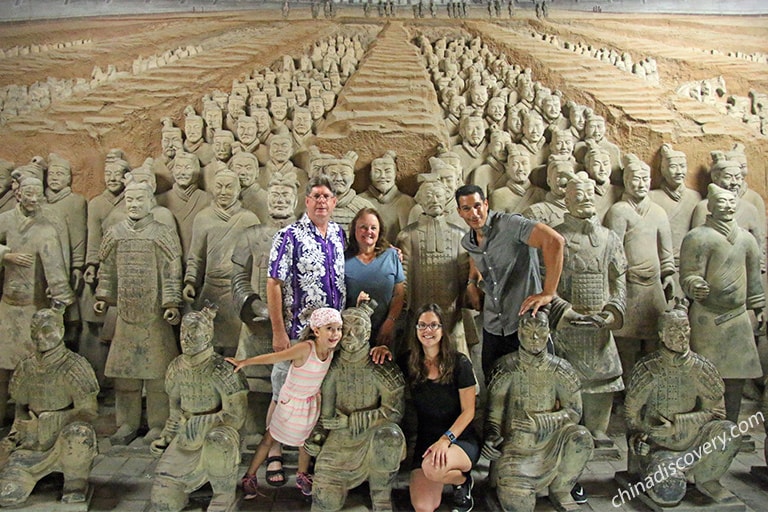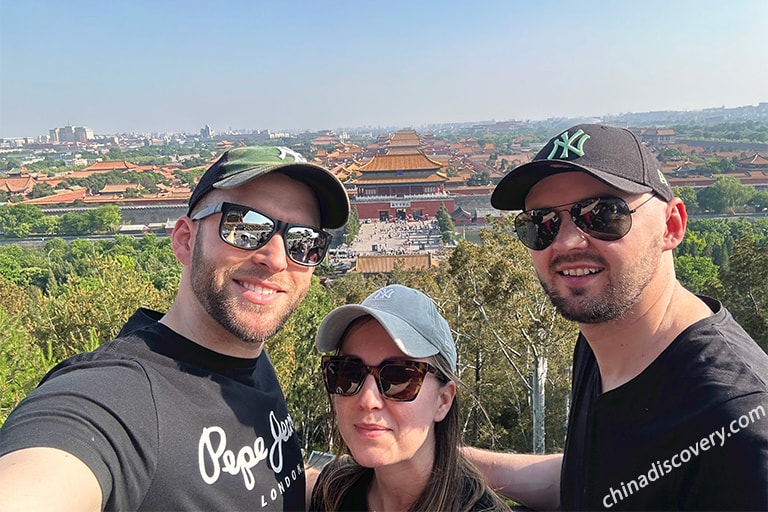The Treasure Gallery - The Highest Level of Court Craftsmanship in the Qing Dynasty
Located in the Forbidden City in the area of the Palace of Tranquil Longevity (宁寿宫), the Treasure Gallery has been one of the Palace Museum's most important permanent exhibitions since the gallery’s opening in 1958. Having previously undergone several renovations, the Treasure Gallery has once again been upgraded with four spaces, including the south and north galleries of the western corridor halls flanking the Hall of Imperial Supremacy (皇极殿).
Ticket Price:
◆ Forbidden City Tickets:
April 1st - October 31st (high season) CNY 60
November 1st - March 31st (low season) CNY 40
◆ Optional Tickets:
The Treasure Gallery CNY 10
Tickets for the Treasure Gallery are not included in the Forbidden City tickets and need to be purchased separately.
>> Check more about How to Book Forbidden City (Palace Museum) Tickets from Official Website
Opening Hours:
①April 1st - October 31st: 8:30 AM - 5:00 PM (Opening time for admission: 8:30 ; Last admission: 16:10)
November 1st - March 31st: 8:30 AM - 4:30 PM (Opening time for admission: 8:30 ; Last admission: 15:40)
②The Treasure Gallery is open from Tuesday to Sunday and closed on Mondays except for statutory holidays.
Location:
The Palace of Tranquil Longevity Area, including the Gallery of Qing Imperial Opera and the Stone Drum Gallery
With an area of approximately 220 square meters, the south gallery in the western corridor showcases artificial potted landscapes artfully made with gems, gold, silver, pearls, coral, ivory, enamel, lacquered wood, and other materials. Imbued with auspicious significance, these splendid works were indispensable ornamentations in the Qing-dynasty (1644-1911) court during festivals and ceremonies. Also presented to the court as a form of tribute, these artworks reflect unique characteristics of the lavish lifestyle enjoyed by the Qing imperial clan.
The north gallery in the western corridor of the Hall of Imperial Supremacy is approximately 340 meters square and houses works of jade and other colorful semi-precious stones. Jade carving is an integral part of China’s ancient cultural heritage. The Qing court oversaw the apex of this artform through the meticulous selection of materials and expert craftsmanship. Other fine works made of agate, crystal, lapis lazuli, turquoise, malachite, rose quartz, Shoushan stone, and other materials display the artistry of the Qing dynasty.
In the south gallery, there is an urn carved from green jade with a dragon-among-clouds designed as a testament to the exquisite artisanship of the mid to late Qianlong reign. Additionally, the north gallery has a cabinet of curiosities displaying works of jade, ceramics, enamel, glass, and other materials.
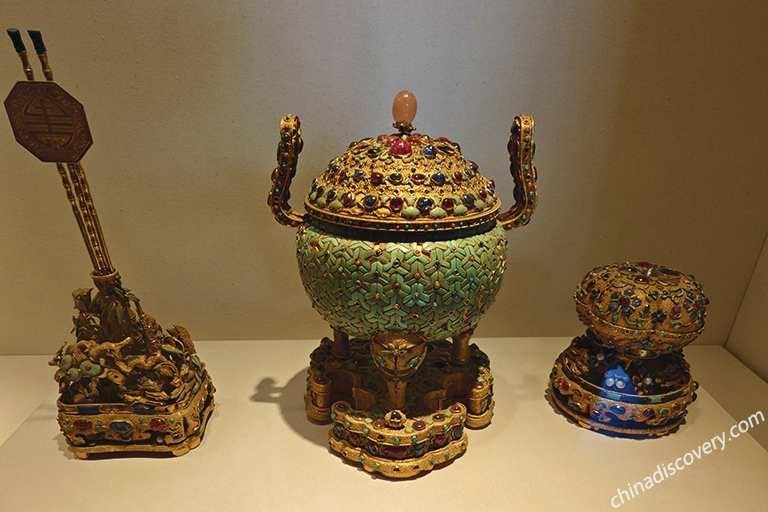 Beautifully Crafted Enamelled Goldware
Beautifully Crafted Enamelled Goldware
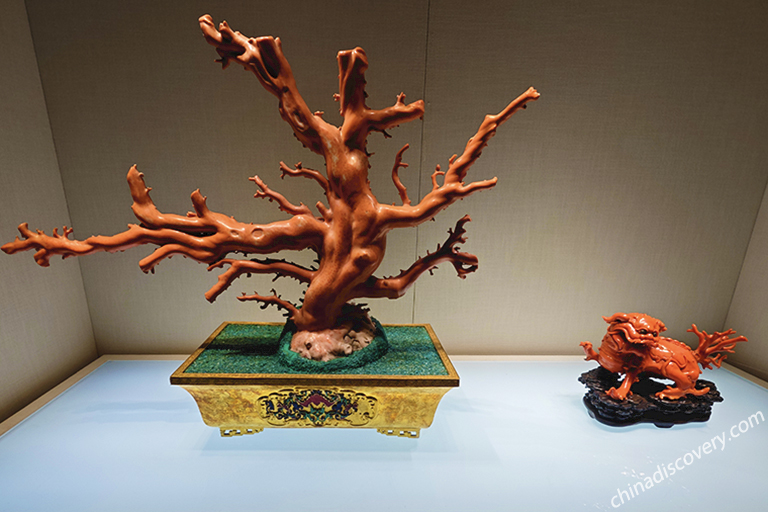 Red Coral Jade Carved Bonsai
Red Coral Jade Carved Bonsai
Most of treasures in gallery were made by the manufacturing office in palace, and some were tributes from local officials during the New Year's celebrations. Most of these treasures are made of precious materials such as gold, silver, jade, emerald, pearls and various precious stones, and are designed and manufactured by famous craftsmen from the whole nation, representing the highest level of craftsmanship of that time. In terms of application, it is widely involved in various fields such as court rules and rituals, religious sacrifices, daily life and leisure and enjoyment, showing the supremacy and dignity of imperial power everywhere, and the royal grace and elegance reflect the style of that era in a specific and subtle way.
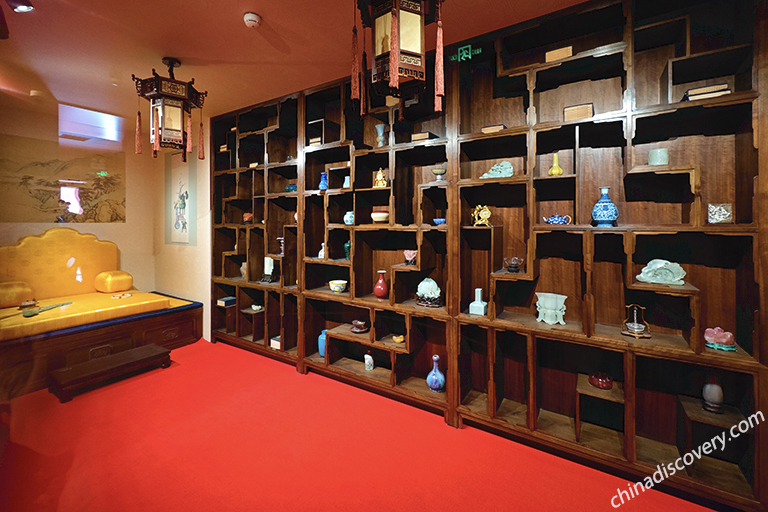 Cabinet Displays Various Treasures
Cabinet Displays Various Treasures
>> Check more about What Treasures Are Collected in the Palace Museum (Forbidden City)
The significance of these treasures today has gone far beyond the value of simple materials and craftsmanship, they reflect the profound heritage of Chinese traditional culture, are the expressive portrayal of that period of history, and are the brilliant treasures condensed by the spirit of the Chinese nation.
How to plan your Forbidden City trip
To explore the Forbidden City and the best highlights of Beijing, including Great Wall, Temple of Heaven, Summer Palace, Tiananmen Square and Hutongs, you need at least 3 or 4 full days, which is available up to 144 Hours Visa-free for Transit in Beijing. If you have more days, you can go for an in-depth Great Wall hiking or photography, and explore more hidden attractions in Beijing. We have helped many global travelers enjoy their memorable wonderful trips to Beijing for the past few years. You can find your favorite tour package from our valuable Beijing private tours collections.
As the most popular transportation hub in China, you can easily travel from Beijing to any other hot travel destinations in China by flight or train, such as Xian, Shanghai, Guilin, Zhangjiajie, Chengdu and other popular destinations in China. China Discovery has designed many great China tour packages from Beijing for you. Please make your choice from our collections or let us customize one for you.
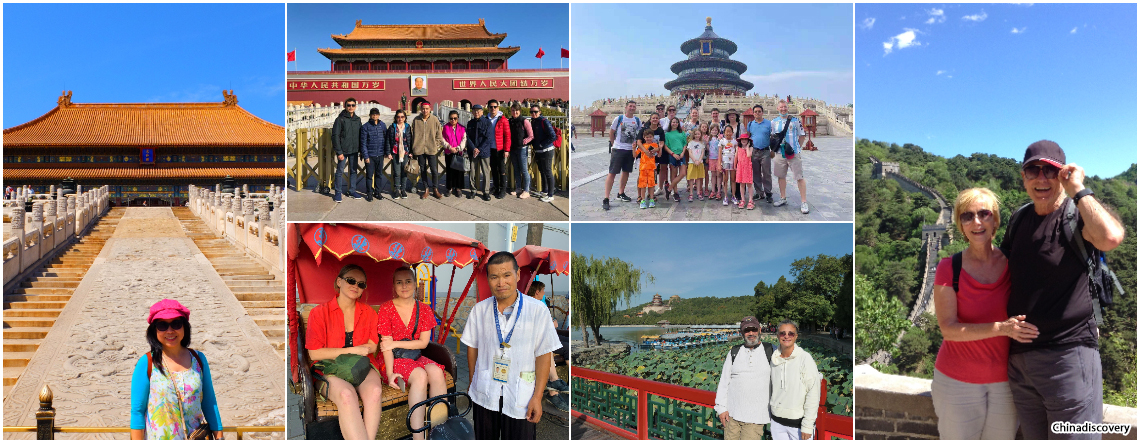
Our Delighted Customers in Beijing
Keep Reading About Forbidden City
- Forbidden City
- Forbidden City Travel Tips
- Forbidden City Facts
- Hall of Supreme Harmony
- Imperial Garden
- Nine-dragon Screen
- The Gallery of Clocks
- Palace Museum Collections
- Forbidden City Map
- How to Visit the Forbidden City
- Forbidden City Photography Tips
- Forbidden City Weather & Seasons
- How to Book Forbidden City Tickets
- How to Get to Forbidden City
- How to Transfer from Beijing Airports
Top Beijing Tours & Travel Guide
- Forbidden City Tours
- Popular Beijing Tours
- Great Wall Hiking Tours
- Beijing Visa Free Tours
- Beijing Layover Tours
- Tpo 6 Beijing Vacations
- Beijing Family Tours
- Beijing Travel Guide
- Beijing Travel Articles
- Great Wall Trip Planning Guide
- How to Plan a Beijing Trip
- Things to do in Beijing
- Top Experiences Recommended by LP
- Featured Activities in Beijing
- How to Get to & around Beijing
- Weather & Seasons in Beijing
- Beijing Maps
- Beijing 144/24 Hour Visa Free
- Recommended Hotels in Beijing
- Beijing Photo Gallery
- Top Beijing Food and Snacks
- Beijing Shopping
- Beijing Nightlife
- Beijing FAQs & Tips
Recommended Beijing Tours
Top 3 Beijing tours chosen by most customers to explore Beijing in the best way. Check the detailed itinerary, or tailor your own trip now with us.

8 Days Best of China Tour (Flight/Bullet Train Covered)
Beijing / Xian / Shanghai
Start planning your tailor-made holiday to China by contacting one of our specialists. Once inquired, you’ll get a response within 0.5~23.5 hours.
Customize a TripHave a question? Get answers from our travel experts or guests
- Your Question:
- Your Name:
- Your Email:
- Submit


























